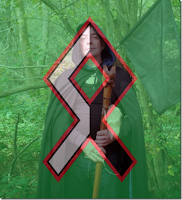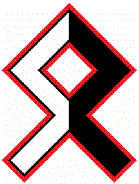The term Odic-Force or originally Od was used by Baron von Reichenbach (1788 - 1868) to mean a hypothetical force which pervades all of Nature - 'hypothetical' that is to those who do not recognise it for what it is.
It would seem rather obvious to note that this Od forms the basis of the Odal-Rune or Edel-Rune, and also that of Od-in. 'Od-in' or 'Od-an' means 'Master of Od', '-an' meaning 'master of' when added to a word. Woden (Wod-en) or Wodan (Wod-an) is thus the 'Master of Wod'. 'Wod' and 'Od' are the same thing, just spelled differently in different peoples.
Science uses the suffix '-od' in various words -
- biod -the od of animal life,
- chymod - the od of chemicals,
- crystallod - the od of crystals,
- elod - the od of electricity,
- heliod - the od of the Sun,
- magnetod - magnetic od,
- selenod/artemod - the od of the Moon,
- thermod - heat od.
These can be found in the Oxford English Dictionary and are not 'invented'. This force is especially strong in magnets, crystals heat, light and chemical action. The rune-name 'od-al' or 'ed-el' could be seen as 'od' (Odic-Force) and 'el' (Light) - suggesting that this is a Force of Light whose knowledge can be found in this rune-stave. The mastery of this Odic-Force can also be found within the rune-stave.
The Aryan Root *wuot- is the root of the name 'Wuot-an', a name which means 'Master of the Wuot' as we can gleam from what has been said already. In the name 'Godan' or 'Guodan' we can see this force as 'God' or 'Guod' and Godan/Guodan is another form of Woden used by the Langobards. 'Wood' and 'Wod' have similar sounds, which suggests to me that the 'woodlands', the haunt of Woden-Herne, are a powerful source of this Universal Force.
When swathes of woodlands are cut down and the ancient forests destroyed the people degenerate and come closer to being destroyed themselves. After World War II the ancient forests of Germany were razed to the ground by an insatiable lust for destruction - or to try to destroy this powerful force? This destruction has increased manyfold since World War II in all areas of the world - is this really a 'coincidence'. The Odic-Force or 'Woda-Force' is clearly linked to the god Woden through the name, but also through his association with the trees and the ancient forests. The figure of Robin Hood is the most remembered Folk-Hero of the English, and survives several attempts to distort the Primal Image in TV shows and films. Robin Hood is a dim remembrance of the god Woden-Herne; he is 'Fame-Bright Hooden' or 'Fame-Bright Woden'. The Edel-Rune, as Hamasson has pointed out before, is a glyph of The Hooded One or The Hooded Man.
The 'Double Sieg-Runes' that make up the Edel-Rune suggest a shift to the esoteric - the 'inner' since both face inwards. (This can be seen better in the above where we have a White 'S' and Black 'S', being part of the wholeness of the rune, and also suggesting the Balance of the Power of Light and the Power of Darkness. We could suggest that the key to unlocking this force is in fact - The balance of the Power of Light and the Power of Darkness. This can be likened at this level to the balance of the Right and Left hemispheres of the brain. This is the 'Gift of Ing' as seen in the form of the rune.
It would seem fairly obvious that the Odic-Force has to be associated with the ideas suggested in the Root *wod-/*od- which are -
- divine madness,
- intoxication,
- ecstatic state of consciousness,
- swift-moving force,
- spiritual ('od') force.
Freya, in legend, loses her 'Od'; she is married to Od, as Frigga is married to Od-in. At one time Frigga loses her Od-in when he is banished from Asgard. They are one and the same goddess. The Goddess Idunn (Id-unn) has the same concept within her name. Indeed the name 'Id-an' comes to mind here which may be something to ponder upon. We can thus perhaps relate the following terms to the Odic-Force -
Wad - Wed - Wid - Wod - Wud
Wat - Wet - Wit - Wot - Wut
When we table this as above we can see so many links between god-names, examples being Wodan-Woden and Wade-Wate, as well as Wid-Wit since we find variations of the name Widu-kind and Witte-kind. We can also place a 'V' where the 'W' is to gain further insights.
'The forest should only be tended by people who love it. Those who view it as an object of vulgar speculation not only harm the forest, but everything that crawls on the face of this Earth as well; for the forest is the cradle of water. If the forest dies, then the springs dry up and the pastures are laid to waste. The Earth will then be engulfed by a restlessness from which none of us will escape. The rescue of the forest signifies the rescue of peace.'
Viktor Schauberger - Vienna October 1936.
According to Viktor Schauberger the key to the power of the forests over all life lies in water. In the above table wat of course is also the root of 'water' and Woden is connected to 'water' through his name, as is Wade or Wate, the father of Weland the Smith. According to his ideas water-blood-sap are not circulated by any mechanical means but by a form of energy-transformation.
The shape of the Lagu-Rune, the Rune of Water, shows a form of 'fountain' where the water moves upwards through the upright-stave. This same movement can be found in the Eohls-Rune or 'Life-Rune' where there is an upward-movement into the branches of the tree as the sap rises within the trunk. Water, according to Schauberger, originates from the Ur-Will, again linking this to Woden-Will-Weoh. The two polarities of male (Ur-Father) and female (Ur-Mother) when in balance produce the 'child', i.e. create a third force or 'life'. This is the truth hidden within The Hooded Man Prophecy -
'In the days of the Lion, spawned of the Evil Brood, The Hooded Man shall come to the forest. There he will meet with Herne the Hunter - Lord of the Trees - to be his Son and do his bidding. The Power of Light and the Power of Darkness shall be strong within him. And the guilty shall tremble.'
The essence of this is not merely the prophecy of a 'Coming Man' or 'English Folk-Hero' but is also concerned with the powers that bring into being all life, the balance of opposites that create a third. The alien religions of Judaism, Islam and Christianity suppressed the female and thus created the imbalance we see in the world today. A backlash to this was inevitable but has today began the process of replacing this male dominance by a female dominance, which again will create the necessary unbalance needed to sustain the Old Order and its destructive energies. The Hooded Man and his sword - Albion - are symbolic of the balance of the Power of Light and the Power of Darkness in the individual. The balance of the Spear (Gral) and the Chalice (Graal). When the Spear is plunged into the Graal the birth of the 'Son' occurs.
The power of the Sun is female, but the Rays of the Sun that affect the Earth are male. This seems clear in the figure of Sunna as the female Sun and Ingwe as the 'Rays of the Sun' as they hit the Earth. These are the Golden Bristles of the Boar - Ingwe-Frey. Thus the Avatar is a man-child emanating from the Goddess Sunna - the 'Son' born of the 'Mother', the secret of the 'Virgin Birth'.
I have digressed somewhat (as usual) but all of these things seem to fit together in a pattern or form. The secret to fertility and the fertile land was known by the English as we can see from the Acerblot and the call to the union (Sacred Marriage) of the Sky-Father and the Earth-Mother. The Ur-th Mother or Ur-Mother is Erce, a word which appears to come from the Greco-Latin arche which is the root of 'archetype', and thus cognate to Ur in Teutonic Lore. IR/UR is the Ur-Father and ERCE/URCE is the Ur-Mother. These are parts of this Odic-Force or Universal Life-Force, the 'polarities' of the Odic-Force.

















